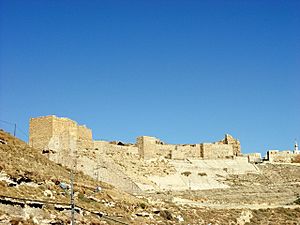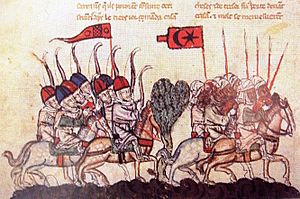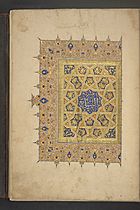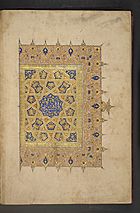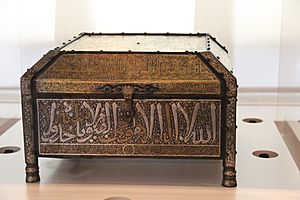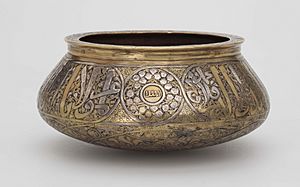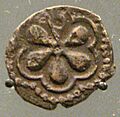Al-Nasir Muhammad facts for kids
Quick facts for kids An-Nasir Muhammadالناصر محمد |
|||||
|---|---|---|---|---|---|
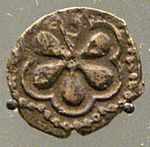
Al-Nasir Muhammad copper fals, 1310–1341. British Museum
|
|||||
| Sultan of Egypt (First reign) |
|||||
| Reign | December 1293 – December 1294 | ||||
| Predecessor | Al-Ashraf Khalil | ||||
| Successor | Kitbugha | ||||
| Regent | Kitbugha | ||||
| Second reign | |||||
| Reign | 16 January 1299 – March 1309 | ||||
| Predecessor | Lajin | ||||
| Successor | Baybars II | ||||
| Regent | Baybars II and Sayf al-Din Salar | ||||
| Third reign | |||||
| Reign | 5 March 1310 – 7 June 1341 | ||||
| Predecessor | Baybars II | ||||
| Successor | Saif ad-Din Abu-Bakr | ||||
| Born | 16 Muḥarram 684/24 March 1285 Cairo, Mamluk Sultanate |
||||
| Died | 21 Dhū al-Ḥijja 741/7 June 1341 (age 56) | ||||
| Consorts |
|
||||
| Issue | |||||
|
|||||
| House | Qalawuni | ||||
| Dynasty | Bahri | ||||
| Father | Qalawun | ||||
| Mother | Ashlūn bint Shaktāy | ||||
| Religion | Sunni Islam | ||||
An-Nasir Muhammad (1285–1341) was a powerful Mamluk sultan of Egypt. He ruled three separate times: from 1293–1294, 1299–1309, and 1310 until his death in 1341. In his first two reigns, other powerful leaders controlled him. But by his third reign, An-Nasir was determined to be the true ruler. He made sure no one else could take away his power.
An-Nasir was known for giving important military jobs to people he trusted, even if they weren't Mamluks. He also removed taxes that made life harder for common people. He appointed a special judge, Emir Ibn al-Waziri, who was known for fighting corruption.
Contents
Life of An-Nasir Muhammad
An-Nasir Muhammad was the youngest son of Sultan Qalawun. He was born in Cairo in a place called Qal'at al-Jabal, which means "Citadel of the Mountain." His father was from a Turkic tribe, and his mother was of Mongol background.
An-Nasir Muhammad married a Turkic woman named Khawand Toghay. She was once his slave but he set her free. They had a son named Prince Anuk.
His time as sultan can be divided into three main parts because he was removed from power once and chose to step down once.
First Reign (1293–1294)
An-Nasir Muhammad became sultan in December 1293 after his brother, al-Ashraf Khalil, was killed. An-Nasir was only 9 years old, so he was sultan only in name. Two powerful leaders, Zayn-ad-Din Kitbugha and Emir ‘Alam al-Din Sanjar al-Shuja‘i, were the real rulers of Egypt.
Kitbugha and al-Shuja‘i were rivals and did not get along. Al-Shuja‘i tried to arrest Kitbugha, but Kitbugha fought back. The conflict ended with al-Shuja‘i's death.
Later, another emir named Lajin convinced Kitbugha to remove An-Nasir from power. Kitbugha then became sultan himself. An-Nasir, who was 10 years old, was sent with his mother to al-Karak, a strong castle. This ended his first time as sultan.
Second Reign (1299–1309)
In 1296, Kitbugha was removed from power by Lajin. Lajin ruled as sultan until he was killed in 1299. After Lajin's death, the powerful leaders decided to bring An-Nasir Muhammad back from Karak to be sultan again.
An-Nasir returned to Cairo with his mother, and people celebrated his return. He was 14 years old. Again, he was a sultan mostly in name. The real power was held by two strong leaders: Sayf al-Din Salar and Baibars al-Jashnakir.
During this time, a group of Mamluks called the Burjis became very powerful. They made people pay "Himayah," which were special payments for their services or protection. There was also a rebellion in Upper Egypt by Bedouin tribes, which the army quickly stopped.
The Battle of Wadi al-Khazandar (1299)
News came that Ghazan, a Mongol ruler from the Ilkhanate, was planning to attack Syria. In 1299, An-Nasir led the Egyptian army to Syria to face Ghazan's forces.
An-Nasir's army (about 20,000 soldiers) fought Ghazan's army (about 12,000 soldiers) in a battle known as the Battle of Wadi al-Khazandar. An-Nasir's army was defeated and retreated. Ghazan then took control of Homs and his soldiers took things from Damascus. Many people from Damascus fled to Egypt.
After the defeat, many Syrian refugees came to Cairo. An-Nasir and his leaders prepared for a new fight. They collected money, horses, and weapons. Luckily, Ghazan left Syria, and An-Nasir was able to regain control of the region.
During his second reign, An-Nasir's forces also attacked parts of Armenian Cilicia and the island of Arwad, which was used by Crusaders to attack Muslim ships.
In 1308, An-Nasir allowed Georgians to celebrate on Calvary and stay at the Church of the Holy Sepulchre.
The Battle of Marj al-Saffar (1303)
In 1303, Ghazan's army again crossed the Euphrates River and moved towards Syria. An-Nasir and his army arrived in Syria from Egypt. They decided to fight the Mongol forces at Marj al-Saffar.
On April 20, An-Nasir's army, with the Caliph (a religious leader) by his side, faced a Mongol army of 50,000 soldiers. The battle was fierce. At one point, many thought An-Nasir's army was defeated, but they held strong. The Mongol commander, Qutlugh-Shah, was surprised to see the Egyptian army still fighting. He eventually fled.
The next morning, Qutlugh-Shah tried to fight again but was defeated. His army was completely destroyed. When Ghazan heard about this huge defeat, he was so upset that he died a year later. An-Nasir returned to Egypt to great celebrations. Cairo was decorated to welcome him.
Achievements and Withdrawal
In 1304, An-Nasir's forces raided Sis again. He also had the gate of the Cathedral of Acre, which had been brought to Egypt earlier, installed at the Madrasah Al-Nasiryah.
By 1309, An-Nasir was tired of being controlled by Salar and Baibars al-Jashnakir. He pretended he was going on a pilgrimage to Mecca, but instead, he went to al-Karak and stayed there. He didn't want to rule if he couldn't have full power. He hoped to gather support from other leaders in Syria. When An-Nasir refused to return, Baibars made himself the new Sultan of Egypt.
Third Reign (1310–1341)

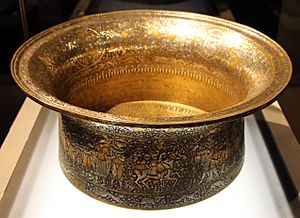
Baibars al-Jashnakir ruled Egypt for about ten months. His rule was difficult, with unrest and threats. The people of Egypt disliked him and wanted An-Nasir Muhammad back. Baibars was forced to step down and flee.
An-Nasir returned to Egypt. He was now 24 years old and determined to be the true sultan, not controlled by anyone. He had Baibars executed and accepted Salar's resignation. Salar later died in prison. An-Nasir took control of their wealth and properties.
An-Nasir became very careful and suspicious of plots against him. He even sent the Caliph away from Cairo for a time.
Crackdown on Corruption
An-Nasir slowly gained more power. He punished leaders who had treated him badly or plotted against him. He got rid of some official jobs and took back money and property from corrupt officials. He also stopped the special taxes that had made officials rich and powerful, making life easier for common people.
He appointed Emir Ibn al-Waziri, known for being tough on corruption, to lead the Court of Justice. Every Monday, An-Nasir himself would listen to complaints from ordinary people against officials and leaders. He also stopped governors from punishing people without his permission and closed a famous prison. In 1315, he ordered a survey of all land to make sure taxes were fair.
Internal and External Situations
During An-Nasir Muhammad's third reign, Egypt faced fewer big threats from outside. Both the Crusaders and the Mongols were weaker from past battles and their own problems. However, there were some small problems in Upper Egypt with Arab tribes, which were easily handled.
In 1321, there were some problems between Muslim and Christian communities in Egypt, with churches being destroyed and fires in Cairo. Some Christians were arrested.
Even though Egypt's economy grew during An-Nasir's third reign, there were some money problems because of bad coins. An-Nasir made thousands of new coins to fix this.
Under An-Nasir, Egypt became a very strong political power. Kings and foreign groups often visited Cairo, bringing gifts and asking for An-Nasir's help and friendship. This included visitors from Pope John XXII and King Philip VI of France. The Pope's visitors asked An-Nasir to treat Christians well and protect holy places. King Philip VI's group asked for the city of Jerusalem, but An-Nasir refused and sent them away.
Public Works
An-Nasir Muhammad's long rule was a golden age for Mamluk power and culture in Egypt. He started many amazing building projects. He had the canal connecting Alexandria to the Nile River dug again, which was a huge effort.
In Cairo, he built a large public square called al-Midan al-Nasiri. He also made big additions to the Citadel, including a beautiful palace, a new mosque, and a water system. He built many schools (madrasas), public baths, and fixed more than thirty mosques. His own Mosque in the Citadel, which still stands today, was decorated with stones from the ruined cathedral of Acre. He also added Cairo's first sabil (a public fountain) to his father's buildings, which was especially helpful for poor people.
Account of Al-Malik An-Nasir in Ibn Battuta's book
The famous traveler Ibn Battuta visited Cairo when An-Nasir Muhammad was the sultan.
An-Nasir Muhammad's emblems and coins
An-Nasir Muhammad had many symbols, or emblems. Some of these included an eagle, a flower, a lily, and a "Bundel" (a symbol for an official in charge of the Sultan's clothes).
His coins from his second reign had his name as "al-Sultan al-Malik an-Nasir Nasir ad-Donya wa al-Din" (The Sultan King An-Nasir, triumphant in faith and the world).
In his third reign, his coins had special titles that were unique in Mamluk history, such as "The Greatest Sultan King" and "The Sultan King triumphant in the temporal world and in faith." His coins also had phrases like "May his victories be glorified" and "May God make his kingdom and his Sultanate eternal."
Family
The historian Ibn Iyas wrote that An-Nasir Muhammad's name was known everywhere, and all kings respected and feared him. He had complete control over Egypt.
An-Nasir Muhammad was a very important sultan. His father and brother were also famous sultans. Eight of his sons and four of his grandsons later became sultans of Egypt, showing how powerful and influential his family was.
His children included:
Images for kids
See also
 In Spanish: An-Nassir Muhammad para niños
In Spanish: An-Nassir Muhammad para niños
- List of rulers of Egypt
- Nâçerî


